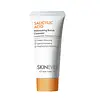What's inside
What's inside
 Key Ingredients
Key Ingredients

 Benefits
Benefits

 Concerns
Concerns

 Ingredients Side-by-side
Ingredients Side-by-side

Water
Skin ConditioningGlycerin
HumectantButylene Glycol
HumectantAvena Sativa Kernel Flour
AbrasivePoloxamer 188
EmulsifyingDecyl Glucoside
CleansingZea Mays Starch
AbsorbentAcrylates/C10-30 Alkyl Acrylate Crosspolymer
Emulsion StabilisingCaprylyl Glycol
EmollientDisodium EDTA
Ethylhexylglycerin
Skin ConditioningCocamidopropyl Betaine
CleansingCentella Asiatica Extract
CleansingPhenoxyethanol
PreservativeCeramide EOP
Skin ConditioningSodium PCA
HumectantCeramide NP
Skin ConditioningSaccharide Isomerate
HumectantCeramide AP
Skin ConditioningSodium Polyacrylate
AbsorbentSodium Hydroxide
BufferingSodium Hyaluronate
HumectantWater, Glycerin, Butylene Glycol, Avena Sativa Kernel Flour, Poloxamer 188, Decyl Glucoside, Zea Mays Starch, Acrylates/C10-30 Alkyl Acrylate Crosspolymer, Caprylyl Glycol, Disodium EDTA, Ethylhexylglycerin, Cocamidopropyl Betaine, Centella Asiatica Extract, Phenoxyethanol, Ceramide EOP, Sodium PCA, Ceramide NP, Saccharide Isomerate, Ceramide AP, Sodium Polyacrylate, Sodium Hydroxide, Sodium Hyaluronate
Water
Skin ConditioningCocamidopropyl Betaine
CleansingPotassium Cocoyl Hydrolyzed Oat Protein
Skin ConditioningSodium Cocoyl Glycinate
CleansingSodium Lauroyl Sarcosinate
CleansingCorn Starch Modified
AbsorbentHydrated Silica
AbrasiveGlycerin
HumectantSalicylic Acid
MaskingNiacinamide
SmoothingCentella Asiatica Extract
CleansingAloe Barbadensis Leaf Extract
EmollientCamellia Sinensis Leaf Extract
AntimicrobialCalendula Officinalis Flower Extract
MaskingCeramide NP
Skin ConditioningDMDM Hydantoin
PreservativePanthenol
Skin ConditioningAllantoin
Skin ConditioningWater, Cocamidopropyl Betaine, Potassium Cocoyl Hydrolyzed Oat Protein, Sodium Cocoyl Glycinate, Sodium Lauroyl Sarcosinate, Corn Starch Modified, Hydrated Silica, Glycerin, Salicylic Acid, Niacinamide, Centella Asiatica Extract, Aloe Barbadensis Leaf Extract, Camellia Sinensis Leaf Extract, Calendula Officinalis Flower Extract, Ceramide NP, DMDM Hydantoin, Panthenol, Allantoin
 Reviews
Reviews

Ingredients Explained
These ingredients are found in both products.
Ingredients higher up in an ingredient list are typically present in a larger amount.
Centella Asiatica Extract (Centella) is derived from an herb native to Southeast Asia. It is famous for its anti-inflammatory and soothing properties.
Centella is rich in antioxidants and amino acids, such as Madecassic Acid and Asiaticoside.
Studies show the compounds in centella help with:
The combination of all these properties makes centella effective at soothing, hydrating, and protecting the skin.
Other great components of centella include Vitamin A, vitamin C, several B vitamins, and Asiatic Acid.
Fun fact: Centella has been used as a medicine and in food for many centuries. As a medicine, it is used to treat burns, scratches, and wounds.
Learn more about Centella Asiatica ExtractCeramide NP is a type of ceramide and formally known as ceramide 3.
Ceramides are intercellular lipids naturally found in our skin that bonds dead skin cells together to create a barrier. They are known for their ability to hold water and thus are a great ingredient for dry skin.
Ceramides are an important building block for our skin barrier. A stronger barrier helps the skin look more firm and hydrated. By bolstering the skin ceramides act as a barrier against irritating ingredients. This can help with inflammation as well.
If you would like to eat ceramides, sweet potatoes contain a small amount.
Read more about other common types of ceramides here:
Ceramide AP
Ceramide EOP
Cocamidopropyl Betaine is a fatty acid created by mixing similar compounds in coconut oil and dimethylaminopropylamine, a compound with two amino groups.
This ingredient is a surfactant and cleanser. It helps gather the dirt, pollutants, and other impurities in your skin to be washed away. It also helps thicken a product and make the texture more creamy.
Being created from coconut oil means Cocamidopropyl Betaine is hydrating for the skin.
While Cocamidopropyl Betaine was believed to be an allergen, a study from 2012 disproved this. It found two compounds in unpure Cocamidopropyl Betaine to be the irritants: aminoamide and 3-dimethylaminopropylamine. High-grade and pure Cocamidopropyl Betaine did not induce allergic reactions during this study.
Learn more about Cocamidopropyl BetaineGlycerin is already naturally found in your skin. It helps moisturize and protect your skin.
A study from 2016 found glycerin to be more effective as a humectant than AHAs and hyaluronic acid.
As a humectant, it helps the skin stay hydrated by pulling moisture to your skin. The low molecular weight of glycerin allows it to pull moisture into the deeper layers of your skin.
Hydrated skin improves your skin barrier; Your skin barrier helps protect against irritants and bacteria.
Glycerin has also been found to have antimicrobial and antiviral properties. Due to these properties, glycerin is often used in wound and burn treatments.
In cosmetics, glycerin is usually derived from plants such as soybean or palm. However, it can also be sourced from animals, such as tallow or animal fat.
This ingredient is organic, colorless, odorless, and non-toxic.
Glycerin is the name for this ingredient in American English. British English uses Glycerol/Glycerine.
Learn more about GlycerinWater. It's the most common cosmetic ingredient of all. You'll usually see it at the top of ingredient lists, meaning that it makes up the largest part of the product.
So why is it so popular? Water most often acts as a solvent - this means that it helps dissolve other ingredients into the formulation.
You'll also recognize water as that liquid we all need to stay alive. If you see this, drink a glass of water. Stay hydrated!
Learn more about Water